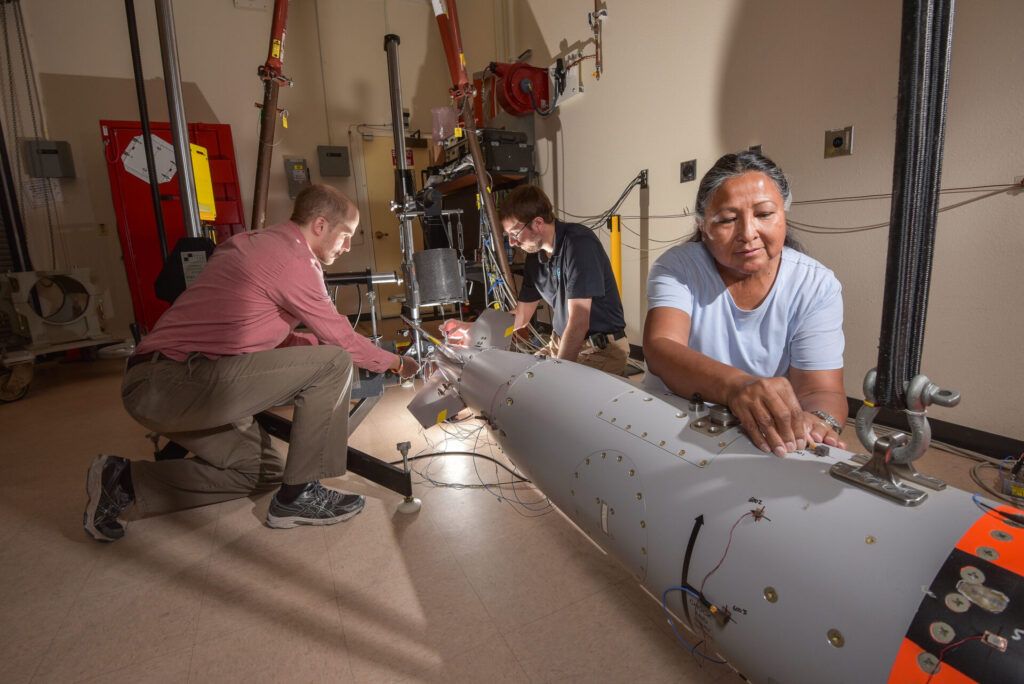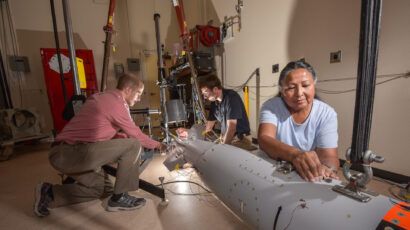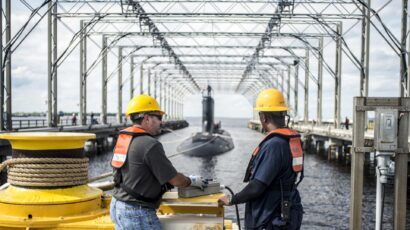DOGE’s staff firing fiasco at the nuclear weapon agency means everything but efficiency
By Stephen Young | April 16, 2025
 NNSA workers at Sandia National Laboratories install measuring equipment on an unarmed B61-12 gravity bomb ahead of a vibration test. (Credit: NNSA, via Flickr)
NNSA workers at Sandia National Laboratories install measuring equipment on an unarmed B61-12 gravity bomb ahead of a vibration test. (Credit: NNSA, via Flickr)
According to a recent press report, the Energy Department has identified 8,500 employees who are “nonessential” and therefore vulnerable to being laid off by Elon Musk’s chainsaw-welding wrecking crew known as the Department of Government Efficiency (DOGE). Of those 8,500 employees, 500 work in the National Nuclear Security Administration (NNSA), the agency responsible for maintaining the US nuclear weapons stockpile. This follows on from a chaotic period in February, when 177 NNSA employees were summarily fired by DOGE. Following a bipartisan uproar, DOGE reversed course, rehiring all but about 27 of the staff who had been laid off.
The media coverage of those forced-then-reversed departures was extensive, with the Washington Post and the New York Times each reporting later the details of the Trump administration operation. But all the coverage, including the latest news, misses two important aspects of this debacle.
Creating chaos in an agency responsible for the safety and security of nuclear weapons is already concerning; the early DOGE firing plan and any new layoffs are very inefficient ways to save taxpayers’ money. According to DOGE, the average salary of the Energy Department’s staff, including the NNSA, is $116,739. If the 500 “nonessential” employees are laid off and all those initially let go were not rehired, it would save approximately $79 million—or about one-third of a percent of the NNSA’s $25 billion budget.
More important, the United States could save tens to hundreds of billions of dollars if it had a sensible and sustainable nuclear modernization plan rather than one that seeks to replace every single weapon in the arsenal—and even create new ones. Such a plan would also have the benefit of removing fuel from the nuclear arms race that President Donald Trump himself has decried.
New security environment. Right now, the NNSA is in the middle of an unnecessary multi-billion-dollar effort to build new and expanded facilities that will produce plutonium pits for new nuclear weapons—the first being made since the end of the Cold War.
The push for new pits usually relies on two arguments—neither of which makes much sense even as they ignore the very high economic, environmental, and geopolitical risks of the path the United States is taking.
First, supporters of new nuclear weapons argue that, as plutonium pits age, they will stop working as expected. In the early 2000s, pit lifetime was estimated at 45 to 60 years. Given that pit production stopped in 1989, that estimate could be a cause for concern, if true. Fortunately, pit lifetime estimates were significantly updated in 2007, when JASON, the federal government’s independent science advisory committee, concluded that most plutonium pits “have credible minimum lifetimes in excess of 100 years as regards aging of plutonium” and that “those with assessed minimum lifetimes of 100 years or less have clear mitigation paths.”
In 2014, Congress passed legislation mandating pit production “driven by the requirement to hedge against technical and geopolitical risk and not solely by the needs of life extension programs.” The law called for demonstrating the capacity to make 80 pits per year by 2027. The “technical” risk highlighted appears tied to pit lifetime—an argument thoroughly refuted by JASON’s reassuring conclusions.
The geopolitical risk perception is more complicated and has become profoundly more so since 2014 when Russia annexed Crimea. In 2018, Russian President Vladimir Putin announced proposals for multiple new types of nuclear weapons, focused on defeating US missile defenses. In 2021, China’s new land-based missile silos were uncovered, with 250 or more eventually spotted. In 2022, Russia invaded Ukraine, and since then has made frequent nuclear threats and posture changes, including stationing nuclear weapons in Belarus.
It is a mistake to believe that new pits and new nuclear weapons are required to keep the United States and its allies safe in this challenging new security environment.
Would Russia not have invaded Ukraine if the United States had been building new types of nuclear weapons? Would China have decided not to build new silos if the United States had already been bulk-producing new plutonium pits? Would Russia not be deploying new types of nuclear weapons if the United States already was?
The answer to all those questions is a clear and resounding no. Russia and China are taking those actions because they already fear the United States and its massive, lethal, and threatening nuclear and conventional military forces. Moving now to resume pit production and make new nuclear weapons only exacerbates the problem, accelerating an already budding nuclear arms race.
Today’s pit production effort. Over time, the 2014 requirement evolved into a goal of producing at least 80 pits per year by 2030. In its attempt to meet this goal, the agency has been updating and expanding operations at the Los Alamos National Laboratory in New Mexico and repurposing an abandoned, unfinished facility at the Savannah River Site in South Carolina.
How much the new plutonium pit production line will cost is uncertain: The NNSA has not provided an official cost estimate. The only clue came in 2024, when then-agency administrator Jill Hruby revealed a new—but still unofficial—cost estimate of $28 to $37 billion for setting up the two pit production sites (not counting program operating costs). A large part of that cost is the construction at the Savannah River Site, which the NNSA estimates will cost between $18 and $25 billion.
These already high-cost estimates still do not include the cost of building the new nuclear warheads those pits will go into. The estimated cost of the first new warhead type, known as the W87-1, has been announced by NNSA as being around $14 billion, with the second warhead type, the W93, costing at least $20 billion.
The NNSA is notorious for its inability to bring in major projects anywhere close to on time or budget. An independent assessment of the NNSA’s pit production plans by the Institute for Defense Analyses, which advises the US government on matters of national security, found that many similar projects “were eventually canceled,” adding that “of the few major projects that were successfully completed, all experienced substantial cost growth and schedule slippage.” The institute also found that projects that cost $700 million or more have taken “at least 16 years” to complete.
The poster child for NNSA’s lack of financial oversight is the already-mentioned unfinished facility in South Carolina that is being repurposed for plutonium pit production. The project was formerly known as the Mixed Oxide (MOX) Fuel Fabrication Facility and was intended to render “excess” weapon-grade plutonium unusable by mixing it with uranium fuel so it could be burned in commercial power reactors, under the Plutonium Management and Disposition Agreement signed with Russia. The project had an initial tag price of $1 billion to build, but it was shut down in 2018 by the first Trump administration after an independent cost estimate found that $7 billion had already been spent on the still-unfinished project and the total life cycle cost would be $56 billion.
NNSA’s failed MOX plant is just one example of the many high-priced projects that the agency ultimately canceled. The stomach-churning part of all this spending is that it is unnecessary to keep the US nuclear stockpile safe and secure. The US national laboratories have a successful record of carrying out life-extension and refurbishment of existing weapons. Much of the US nuclear arsenal has recently undergone such refurbishment, thereby eliminating the need for an expensive, rushed job to make new pits and new nuclear bombs, saving far more in one fell swoop than any DOGE hack job.
Cut new nuclear weapons, not staff ensuring their safety. Joining—and arguably fueling—the new nuclear arms race will come at a nearly unbearable cost for the United States. New plutonium pits and new nuclear warheads are only one fraction of a massive undertaking to rebuild every element of the US nuclear arsenal—every missile silo, every submarine, every bomber, and every bomb and missile they carry—in the name of modernization. Back in 2017, the Congressional Budget Office estimated the US nuclear modernization program would take over $1.2 trillion over 30 years—and that was before taking into account inflation. Since then, to give just one example, the costs for the planned new Sentinel nuclear-armed, land-based, long-range missile have risen by 81 percent, from $77.7 billion to $140.9 billion. Some estimates place the total costs of the modernization program closer to $2 trillion by the time new warheads and delivery systems would enter service.
But the NNSA also plays an enormous role in that cost.
The NNSA annual budget for fiscal 2025 is around $25 billion. This budget includes valuable national security efforts, such as preventing other countries from getting nuclear weapons and controlling excess nuclear materials. But over three-quarters of NNSA’s budget ($20 billion) goes to “weapons activities,” including new plutonium pits and new nuclear warheads. That is $400 billion over the next 20 years for new nuclear weapons.
DOGE’s arbitrary cuts in NNSA staffing were an ill-informed and very poor choice. The US government could save vastly more money by reconsidering the bloated defense programs that the NNSA is responsible for executing compared to the relatively insignificant savings from the haphazard elimination of staff critical for national security.
The NNSA firing debacle questions whether DOGE is serious about reducing wasteful government programs and promoting efficiency. But if Congress and the Trump administration are, they could easily find tens of billions of dollars to save from the NNSA budget so no more taxpayer is used for a new nuclear arms race that the president has said he does not want.
Together, we make the world safer.
The Bulletin elevates expert voices above the noise. But as an independent nonprofit organization, our operations depend on the support of readers like you. Help us continue to deliver quality journalism that holds leaders accountable. Your support of our work at any level is important. In return, we promise our coverage will be understandable, influential, vigilant, solution-oriented, and fair-minded. Together we can make a difference.
















Stephen, I think this is fine as far as it goes. But it doesn’t go very far. You don’t suggest how to save money on pits, for example. Be specific. Do you imagine that the U.S. government is going to stop investing in the capability and capacity to make pits, because of a 19-year old JASON study? That would be quite unrealistic — foolish even.Recall that a subsequent short JASON study recommended acquiring the capacity to make pits as soon as possible. So citing the JASONs to say there is no need to prepare to make pits — is that… Read more »
No wonder the USA is heading for bankruptcy. Utterly ridiculous, astonishing mismanagement that will hasten it’s downfall as China replaces it as the World leader.